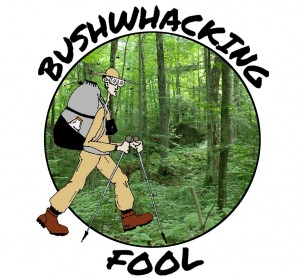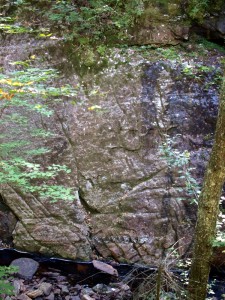
Moshier Creek cliffs
The following is the second part of a report on the fourth day of a bushwhacking trip through the interior of the southern portion of the Pepperbox Wilderness. The majority of the trip follows along streams and beaver vlys with the exit from the area following a marked herd path from the wild interior of this wilderness area. Highlights along the trip included the Threemile Beaver Meadow, Bear Pond, Moshier Creek and Moshier Reservoir. The second part of the fourth day consisted of following along Moshier Creek and becoming dangerously close to walking off the cliffs along the way.
Date: September 3, 2010
Length: 1.10 miles (1.90 miles cumulative)
Difficulty: Easy
Despite the Stillwater 7.5×15 minute quadrangle USGS topographical map there was no pond here along the Moshier Creek (point #45). Instead, there was a shrubby open area with scattered wet spots and small spruce trees, and Moshier Creek running through the middle. I moved out into the open and headed southwest roughly following parallel to the creek despite the frequent wet spots and heavy dew.
Soon the forest encroached on the creek again but only for a brief distance with another clearing surrounding the creek unfolding beyond the line of trees. I stopped under the trees (point #46) and removed my Pinnacle backpack backpack to rest for a moment and take some pictures of the clearing before me.
As I snacked on a Classic Zone Perfect chocolate mint nutrition bar I rock hopped across the stream to check its opposite side for any possible herd paths. After finding nothing but rocky terrain on the opposite side of the creek I returned to my backpack on the western side.
Since I planned on following the creek to Moshier Reservoir and camping off the northwestern shore it made sense to stay on the western side of the creek. This would set me up for a bushwhack northwest tomorrow morning to a beaver vly for a relatively easy exit along the marked hunter’s path I came in on. There was always the chance that once I got over to the eastern shore that I would not find another convenient place to cross back again further downstream.
View Day four, part two in a larger map
The open area surrounding the creek increasingly narrowed as the creek flowed southwest. The thick grass was frequently matted down with flotsam and jetsam scattered throughout it. Obviously, this area was not spared the recent heavy rains. In the sand along the creek I spotted what I thought were beaver tracks. If this were true, this beaver was a far cry from the nearest pond. Perhaps he was scouting out a new location for a vacation home to get away from the hustle and bustle of Moshier Reservoir.
Realizing I had not intentionally left any evidence of my progress on this trip, I purposely stepped into the sand several times. Usually on long bushwhacking trips I leave temporary markers along the way just in case of an emergency. These markers can take many forms from the simplest being foot tracks in the mud to the more sophisticated such as spelling out my initials and the date with some rocks in an exposed area. For some reason I had forgotten to do so thus far on this trip.
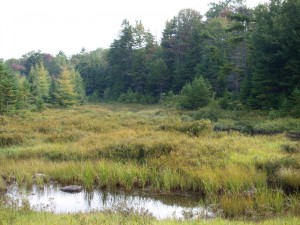
Clearing at Moshier Creek
As the sun gained elevation in the sky its rays dried the morning dew from both the thick, tall grass and my saturated pant legs. Unfortunately, the open sky foretold another hot day; the last one on this trip according to the weather report I heard on my Optimus radio. Rain was forecast for tonight and cooler temperatures with a stiff wind for the last day of my bushwhacking trip.
Just before the narrow open area disappeared and the creek reentered the forest (point #48) I encountered a large, mixed flock of birds scattered about in the tree canopy. The birds fluttered about in the pursuit of insect prey, appearing briefly then disappearing back into the coniferous canopy. Black-capped chickadee, white-breasted nuthatch, black-throated green warbler and yellow-rumped warbler were present plus other species that my rusty fall warbler identification skills prevented me from positively identifying. The tenacious and ubiquitous red-eyed vireo continued to sing nearby and from behind me back in the wider open area along the creek a common yellowthroat sang.
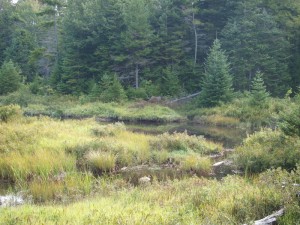
Moshier Creek
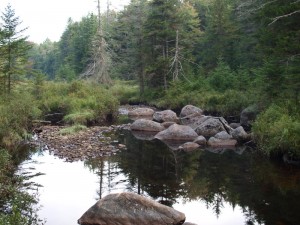
Moshier Creek
After a brief glance of the open area surrounding the creek behind me I disappeared back into the forest following the creek on its inevitable journey down to the reservoir. Almost immediately I located a herd path (point #49) following along the creek until it headed up and over a rise to the west, evidently avoiding the steeper terrain to the south. Since the prospect of being trapped between two cliffs as I rock-hopped all the way down to the reservoir did not appeal to me (although as I write this I feel the experience may have been interesting), I followed the herd path up onto the hillside to the west of the creek.
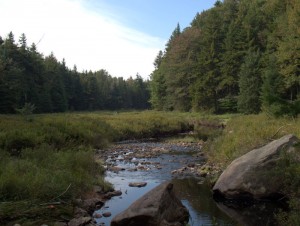
Last open area along Moshier Creek
The herd path proved to be easily followed over the shoulder of a hill. The decent from the top of shoulder was through a hardwood forest of red maple, yellow birch and American beech with much young beech in the understory. The path appeared to have many less distinct side paths going off to the west but perhaps most of them were just in my imagination.
The descent from the shoulder of the hill ended with a small stream crossing (point #50). An old cut log laid across the stream marked the herd path as a popular access into the wilderness at one time. Several more cut logs were noted further south along the path after climbing up another hillside and away from the stream.
Moshier Creek could still be heard off to the east despite the noisy aircraft traffic flying overhead. The canopy prevented me from spotting these planes but I suspected they might be low flying military aircraft on training exercises. Such flights over wilderness areas have been a contentious issue between the military and wilderness advocates. The noise only temporarily ended my feelings of remoteness as my surroundings quickly provided the inspiration for a return to my typical backcountry woolgathering.
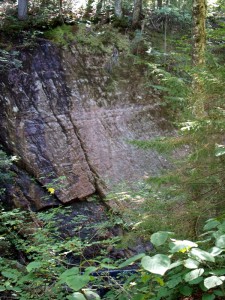
Moshier Creek cliffs
The noise of the cascading water stimulated my curiosity enough that I momentarily left the herd path and headed east toward Moshier Creek. After only a short distance a high granite cliff appeared through the foliage before me (point #51). Fortunately I shifted my focus away from the steep cliff on the opposite side of the creek in time to notice I was dangerously close to the edge of the cliff on my side of the creek. When I found a relatively safe place away from the edge of the abyss I returned to marveling over the high cliff on the eastern side of the creek. The cliff rose from the creek straight up nearly thirty feet where a line of trees perched at the edge as if contemplating jumping off to a certain death on the rocks below.
Returning to the herd path I continued following it back toward Moshier Reservoir off to the southwest. Soon I lost the path as it entered a jumble of rocks and blowdown. After a brief but unsuccessful attempt to reunite with the herd path, I returned to bushwhacking southwest using the sound of the rushing water to the east as my guide. Although it appeared as if I may have reunited with the herd path from time to time I never did follow it on a consistent basis again.
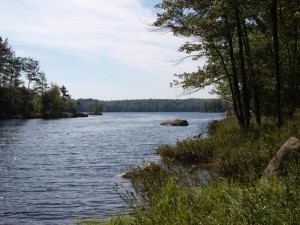
Moshier Reservoir
When I crossed another small stream (point #52) I consulted my Garmin eTrex Legend GPS and was pleased to find myself close to Moshier Reservoir. With a little extra hop in my step I climbed over a small ridge and the reservoir became visible through the forest. I headed straight for the water by a large black cherry tip-up mound just south of where the Moshier Creek enters the reservoir (point #53).
Finally getting to the reservoir was a relief, but the day’s bushwhacking adventure was not over. Before taking on the task of finding an adequate camping site, there were some other chores to take care of, namely lunch, a much-needed bath and some obligatory laundry.
